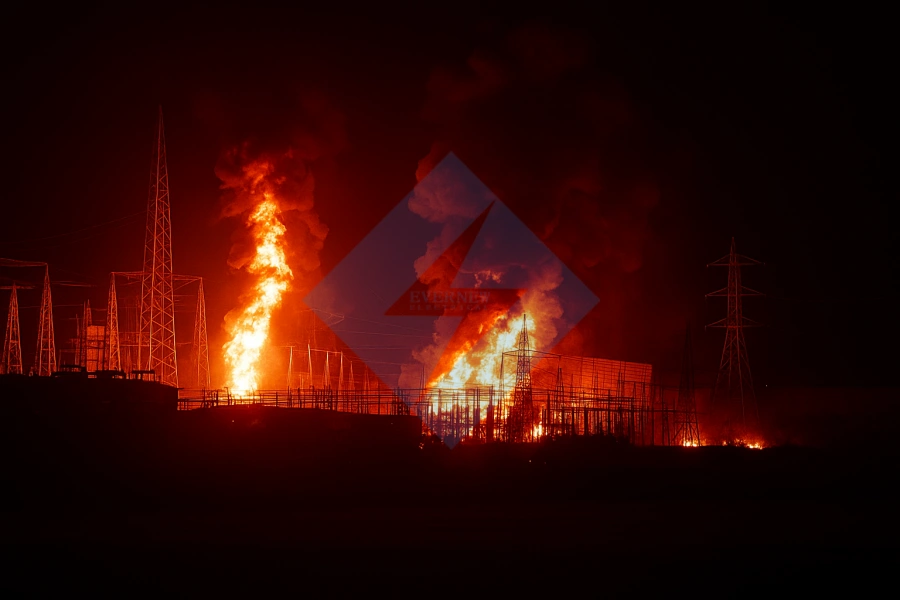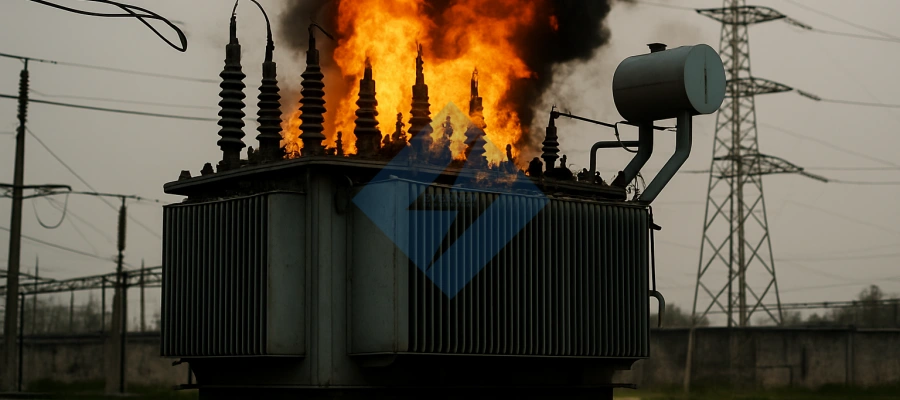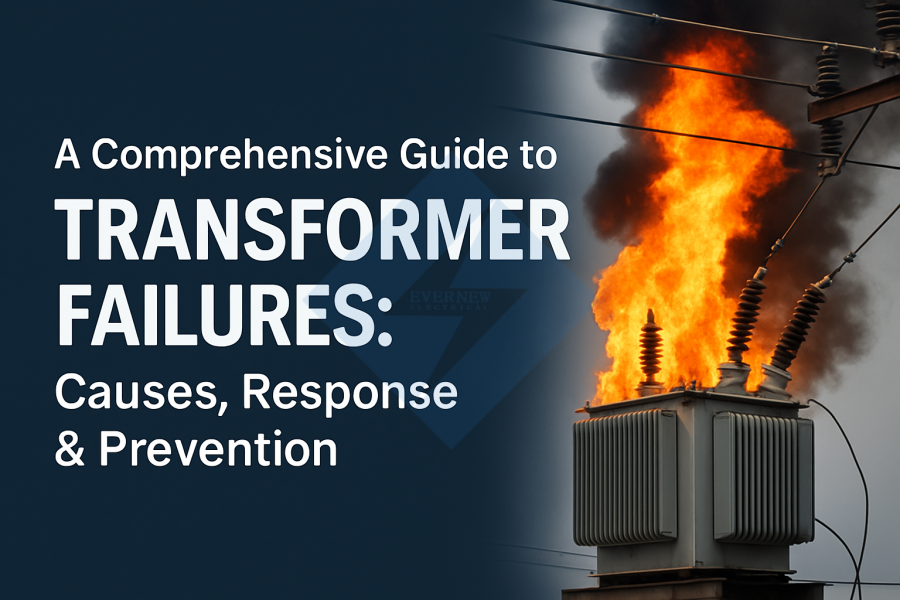In the modern power grid, transformers are the unsung heroes, but when a failure like a burnout or explosion occurs, the consequences can be catastrophic. Such events not only lead to widespread power outages but can also cause fires and pose a serious risk to personnel. This comprehensive guide will dissect the causes of transformer failures, provide a clear plan for emergency response, and outline proactive prevention strategies to help utility companies, industrial operators, and property owners enhance electrical safety.
1. Defining the Failure: Burnout vs. Explosion
First, it’s crucial to understand the difference between a “burnout” and a “transformer explosion.”
- Transformer Burnout: This is a less dramatic but equally serious failure. It typically occurs when a transformer’s windings are damaged due to internal overheating, insulation breakdown, or a localized short circuit. A burnout might not involve a violent physical event but is often signaled by smoke, a burning smell, and abnormal noises.
- Transformer Explosion: This is a severe and dangerous event. When a major internal fault, such as a short circuit, occurs, the intense heat can rapidly vaporize the insulating oil. The sudden, immense pressure generated by this gas expansion can cause the transformer tank to rupture violently, creating a powerful shockwave and a massive fireball (flashover). The tank lid can be blown off, and hot oil can spray over a wide area.
Common Misconceptions: The public often uses the term “explosion” loosely for any loud bang and flash from a transformer. In reality, these events can include:
- Flashover: A surface discharge of electricity across an insulator.
- Arcing: A continuous electrical discharge through a gas, often following an insulation breakdown.
- Rupture: The physical bursting of the tank due to overpressure, which may or may not involve a massive explosion.
Learn More:Blown Transformer? Causes, Prevention, and Reliable Solutions from Evernew Transformer
2. The Root Causes: Six Culprits Behind Transformer Failure
A transformer’s failure is rarely a single-point issue. It’s often the result of multiple factors accumulating over time.
2.1 Electrical Overload and Short Circuits
- Sustained Overloading: Operating a power transformer above its rated capacity for extended periods causes a critical temperature rise, accelerating the degradation of insulating materials like oil and paper.
- Short-Circuit Forces: An external short circuit on the power line can send a massive surge of current through the transformer windings, creating powerful electromagnetic forces. These forces can physically deform the windings, damaging the inter-turn insulation and leading to an internal short.
2.2 Internal Insulation Failure
- Aging or Contaminated Insulating Oil: The insulating oil, or “blood” of the transformer, degrades over time due to heat, producing acidic byproducts and sludge. If the transformer tank seal fails, moisture can enter, drastically reducing the oil’s dielectric strength and insulation capabilities.
- Paper Insulation Breakdown: The paper insulation used in windings becomes brittle with age and heat. Tiny cracks or gas bubbles can lead to partial discharge (corona discharge), which erodes the insulation and eventually causes a thermal breakdown.
2.3 Manufacturing and Design Defects
- Poor Connections: Faulty internal welds or loose connections create high-resistance spots that cause localized overheating.
- Design Flaws: Inadequate winding design, insufficient coil spacing, or loose clamping structures can lead to vibration and electrical discharge, creating a ticking time bomb.
2.4 External Electrical Disturbances
- Lightning Strikes & Surges: Lightning or switching operations on the grid can generate transient overvoltages that exceed the transformer’s insulation rating, causing an insulation failure.
- Inductive Lightning: Even without a direct strike, nearby lightning can induce a voltage surge in the lines connected to the transformer.
2.5 Environmental and Human Factors
- Harsh Environments: Exposure to moisture, salt spray, or corrosive chemicals can degrade the transformer’s enclosure and insulation materials over time.
- Human Error or Animal Intrusion: Incorrect operation of tap changers, digging near underground cables, or small animals (like squirrels) entering the transformer cabinet can cause short circuits.
Learn More:How to Test a Power Transformer? – A Comprehensive Guide by Evernew Transformer

3. Warning Signs: Visual and Auditory Clues of a Failing Transformer
A transformer in distress often gives off clear signals. Recognizing these signs can allow for timely intervention.
3.1 Visual Indicators
- Smoke or Oil Leaks: Any smoke, oil spray, or a visible oil leak from the tank, bushings, or pressure relief device is a critical warning sign.
- Tank Deformation: An unusual swelling or “bulging” of the tank walls, or a broken oil gauge glass, indicates dangerous internal pressure buildup.
- Oil Color Change: A dark, discolored, or muddy appearance of the insulating oil suggests severe thermal stress.
3.2 Auditory Signals
- Abnormal Sounds: Beyond the normal humming, be alert for consistent crackling sounds (arcing), bubbling noises, or a loud, irregular knocking or banging.
- Explosion: A sudden, violent bang is the unmistakable sign of a major failure.
3.3 Olfactory Clues
- Burning Smell: A strong smell of burning paper or plastic points to a severe internal overheating of the solid insulation.
- Hot Oil Smell: A strong, pungent odor similar to hot oil or tar indicates that the insulating fluid is under extreme thermal stress.
4. Emergency Response: What to Do During a Transformer Explosion
In the event of a transformer explosion or fire, personal safety is the top priority.
- Cut the Power Immediately: The most crucial first step is to de-energize the transformer. Quickly locate and operate the corresponding circuit breakers or switches to isolate both the high- and low-voltage sides.
- Maintain a Safe Distance: Do not approach the failing transformer. The risk of a secondary explosion, flying debris, or live cables is extremely high.
- Emergency Notification: Call the fire department (e.g., 911 in the USA, 112 in Europe) immediately if there is a fire. Also, notify the local utility company to report the outage and fault.
- Fire Extinguisher Use: If it is safe to do so, a small fire can be extinguished with a dry chemical or CO2 fire extinguisher. NEVER use water, as it is conductive and can worsen the situation.
5. Post-Failure: Repair, Replacement, and Recovery
After a failure, a professional assessment is required.
- Damage Assessment: Technicians will determine if the transformer is salvageable. If only a minor part of the winding is damaged and the core or tank is intact, a repair might be possible. However, if there’s extensive damage to the core, tank, or major components, a transformer replacement is necessary.
- Repair Process: Repairing a transformer involves complex, specialized procedures like rewinding coils, re-stacking the core, replacing bushings, and performing vacuum oil filling.
- Replacement Timelines: The lead time for a new transformer varies. A standard distribution transformer might be available quickly, while a larger or custom-designed power transformer can take several weeks or months to manufacture.
6. Who to Call When a Transformer Fails
Knowing who to contact in a crisis is critical for a fast and effective response.
- The Fire Department: If there is any smoke, fire, or explosion risk, the fire department is your first call.
- The Utility Company: This is the most important call for a power-related incident. The local utility will dispatch trained crews to safely isolate the equipment and begin restoration efforts.
- Your Insurance Provider: If your equipment is insured, contact your insurance company as soon as possible. They will send a claims adjuster to assess the damage for a potential claim.
- A Professional Service or Original Equipment Manufacturer (OEM): Once the site is safe and the power is isolated, contact a specialized transformer service company or the original manufacturer. They can provide expert technical support, assess the damage, and coordinate either a repair or replacement.
Learn More:Top 10 Mistakes to Avoid When Buying Power Transformers

7. Proactive Prevention: The Best Strategy
Prevention is always better than a cure. A robust maintenance and monitoring program can significantly reduce the risk of a transformer failure.
7.1 Design and Procurement
- Proper Sizing: Always select a transformer with a capacity that exceeds your peak load, with a sufficient safety margin.
- High-Quality Materials: Invest in high-efficiency transformers built with quality silicon steel cores, oxygen-free copper windings, and superior insulating materials.
- Safety Features: Opt for transformers equipped with essential safety features like pressure relief valves, gas relays (Buchholz relay), and surge arresters.
7.2 Routine Operation and Maintenance
- Regular Inspections: Conduct routine visual checks for leaks, signs of corrosion, and abnormal noises.
- Oil Analysis: Periodically take oil samples for chromatographic analysis (DGA). This analysis can detect fault-indicating gases dissolved in the oil, providing an early warning of internal problems like overheating or arcing.
- Thermal Monitoring: Use thermal imaging or an online monitoring system to track the transformer’s temperature and identify hot spots.
- Load Management: Ensure the load on the transformer is balanced across all phases to prevent overheating in one part of the winding.
7.3 Protective Devices and Systems
- Comprehensive Protection: Ensure the transformer is equipped with overcurrent, differential, and ground fault protection relays that are properly calibrated.
- Lightning Arresters: Verify that lightning arresters are correctly installed and in good working condition to protect against voltage surges.
8. Frequently Asked Questions (FAQs)
- How common are transformer explosions?
- With modern manufacturing and regular maintenance, the risk of a transformer explosion is extremely low. However, neglected or aging transformers are at a much higher risk.
- Why do transformers fail more often in hot or stormy weather?
- Heat: High ambient temperatures reduce the transformer’s ability to dissipate heat, accelerating the aging of its insulation system.
- Storms: Lightning and severe weather can cause power surges and overvoltages that can lead to an insulation breakdown.
- How can I tell if a transformer is overheating?
- The most direct way is to check the oil or winding temperature gauges. Other signs include a strong burning smell, a dark oil color, or hot spots visible with a thermal camera.
- Can a non-expert check a transformer for issues?
- Non-professionals can perform a simple visual check for obvious issues like leaks or physical damage. However, NEVER touch or open a transformer enclosure. All hands-on checks and maintenance must be performed by a qualified electrician or technician.
9. Conclusion: Prevention Over Reaction
The safety and reliability of your electrical system are paramount. Understanding the causes of transformer failure and implementing a rigorous preventative maintenance plan is the most effective way to safeguard your assets and people. Proactive measures, from selecting a high-quality transformer manufacturer like Energy Transformer to performing annual professional checkups, are far more valuable than a reactive response.

